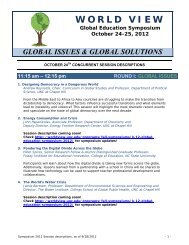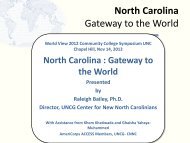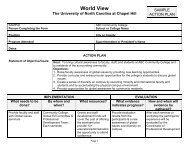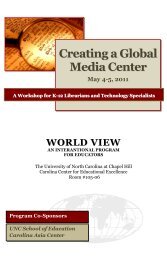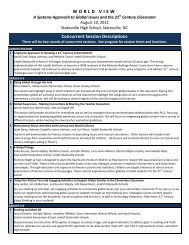The Communication Revolution - World View
The Communication Revolution - World View
The Communication Revolution - World View
You also want an ePaper? Increase the reach of your titles
YUMPU automatically turns print PDFs into web optimized ePapers that Google loves.
<strong>The</strong> <strong>Communication</strong> <strong>Revolution</strong><br />
Christian Lundberg<br />
Department of <strong>Communication</strong> Studies<br />
UNC Chapel Hill
Three Case Studies on the Role<br />
of Media
But first…<br />
• A little food for thought
2009—Iranian Election Protests
Iran<br />
• Long history of “new media” activism—for<br />
example, 1979 revolution and the cassette tape<br />
• Twitter arguably played a significant role in the<br />
2009 election protests—organizing<br />
demonstrations (domestic and global), getting<br />
the word out in a way that circumvented state<br />
controls<br />
• <strong>The</strong>re is some debate about the role Iranian<br />
tweets played
2010-2011—the “Arab Spring”
Basic Timeline<br />
• Revolt in Tunisia begins with self immolation<br />
of Mohammed Bouazizi, 12/19/10<br />
• Riots begin in Algeria on 1/7/11<br />
• 1/17/11 first self immolation in Egypt, mass<br />
protests begin on the 25 th<br />
• On the 16 th mass protests begin in Libya<br />
• Political instability subsequently spreads to<br />
almost all the countries in the region,<br />
including Jordan, Lebanon, Morocco, and Syria
Sidi Bouazid, Tunisia - <strong>The</strong> people of Sidi Bouzid overcame heavy censorship<br />
and police repression to ensure that their uprising did not go unnoticed in<br />
silence.<br />
Protesters took to the streets with "a rock in one hand, a cell phone in the<br />
other," according to Rochdi Horchani - a relative of Mohamed Bouazizi -<br />
who helped break through the media blackout.<br />
Since the same day of the self-immolation of the 26-year-old street vendor<br />
that triggered riots causing the Tunisian leadership to flee the country, family<br />
members and friends used social media to share the news of what was<br />
happening in Sidi Bouzid with international media….<strong>The</strong> key difference in<br />
Sidi Bouzid was that locals fought to get news of what was happening out,<br />
and succeeded.<br />
"We could protest for two years here, but without videos no one would<br />
take any notice of us," Horchani said.<br />
On December 17, he and Ali Bouazizi, a cousin of Mohamed Bouazizi, posted<br />
a video of a peaceful protest led by the young man's mother outside the<br />
municipality building.<br />
That evening, the video was aired on Al Jazeera's Mubasher channel.<br />
http://english.aljazeera.net/indepth/features/2011/01/20111261218159854<br />
83.html
New Social Media was one of the Keys:<br />
• In Egypt, facebook was a critical rallying point<br />
and information clearinghouse—for example,<br />
the 400,000 “fans” of the “we are all Khalid<br />
Siad” page.<br />
• Mobile video, subsequently picked up by<br />
international media outlets helped galvanize<br />
international calls for action in Libya
2011-???—#OWS
How did it start?<br />
• It all began with a tweet from the magazine<br />
Adbusters that said: “What is our one<br />
demand? #OCCUPY WALL STREET”<br />
• <strong>The</strong> tweet linked to this image, which refers to<br />
Egypt’s Tahrir square
From wearethe99percent.tumblr.com
<strong>The</strong> Questions are:<br />
• What can we, as educators, do to help our<br />
students engage and evaluate these events?<br />
• What tools do we need to give them to<br />
understand national and international events<br />
in this media environment?
What is Media Literacy?<br />
• Rooted in the work of two media theorists--<br />
McLuhan and Culkin<br />
• McLuhan is famous for the idea that “the<br />
medium is the message”<br />
• Culkin coined the idea that new technologies<br />
required new forms of literacy
McLuhan<br />
A classical model of the communication<br />
situation looks like this:<br />
Sender Message Receiver<br />
McLuhan argued that this model was<br />
incomplete because the medium, or the way<br />
that the message was conveyed was often as<br />
important as the message itself
Culkin<br />
• Culkin extended McLuhan’s ideas by arguing that<br />
new media required new kinds of literacy.<br />
• Students need to develop literacy skills in writing<br />
and speech, including basic comprehension,<br />
composition, and so on.<br />
• Writing and speech require literacy because they<br />
are both media that convey contents<br />
• Why, asked Culkin, do we not also require basic<br />
literacy training in new media, the most<br />
dominant media in most of our students’ lives?
<strong>The</strong> Dangers of Media Illiteracy<br />
• Students get locked out of the knowledge<br />
economy.<br />
• It is an element in the new core standards<br />
(evaluating evidence and argument, etc.)<br />
• Irresponsible use of social and other forms of<br />
media has bad consequences.
What are the Dangers of Media<br />
Illiteracy in a Globalized <strong>World</strong>?<br />
• A tendency to accept oversimplifications—<br />
students need to be aware of the obvious<br />
motives for media sources to simplify given<br />
time and attention constraints<br />
• An uncritical acceptance of an ethnocentric<br />
worldview—a lack of media literacy makes it<br />
difficult to control for the biases of domestic<br />
news sources
Two Problems<br />
• A theoretical problem—how to get students<br />
to think critically about representations<br />
• An institutional problem—how to help<br />
students understand the constraints of mass<br />
media news as a representation of real events
<strong>The</strong> Problem of Representations<br />
• By “representation” I mean a word, concept or<br />
image that purports to give us a picture of a<br />
real thing or event<br />
What are the problems?<br />
• <strong>The</strong>y are not equivalent with reality<br />
• <strong>The</strong>y are always partial, and so the reveal<br />
some things about the story or event while<br />
concealing others
Examples<br />
• Yasir Arafat’s famous quote that “One person’s<br />
terrorist is another person’s freedom fighter”<br />
(compare the Taliban pre 1989 with the<br />
Taliban post 9/11)
<strong>The</strong> Problem of Media Institutions<br />
What are the underlying issues<br />
• Most media sources are for profit institutions<br />
and therefore they have an incentive to spin<br />
stories to suit the tastes of their clientele<br />
• <strong>The</strong>re are constraints in terms of time,<br />
expertise, and relevance that guide what gets<br />
reported and how it is reported<br />
• Most importantly: Framing
Framing<br />
• In order to make news relevant and easy to<br />
understand, media institutions need to provide<br />
stories with a “frame” that organizes and<br />
arranges the facts<br />
• <strong>The</strong> frame is necessary to turn a collection of<br />
facts into a story<br />
• Media frames require two “gatekeeping”<br />
functions: 1) some stories are in and others are<br />
not 2) some facts are relevant to telling the story<br />
and others are not
Gatekeeping 1<br />
• At the level of what stories are in and what<br />
stories are out, media framing creates<br />
significant distortions<br />
• For example, one common frame is national<br />
interest—but this frame works against a<br />
broader more inclusive worldview<br />
• A specific case: coverage of Africa (AIDS,<br />
Rwanda 90-94’) vs. coverage of instability in<br />
Europe
"<strong>The</strong> international media initially affected<br />
events by their absence. A tree was falling<br />
in the forest and no one was there to hear<br />
it. Only those of us in Rwanda, it seemed,<br />
could hear the sound, because the<br />
international media were not there in any<br />
appreciable numbers at the outset.”<br />
Roman Dalliare, Commander of the UN<br />
Mission to Rwanda
Gatekeeping 2<br />
• But gatekeeping also organizes what facts get<br />
reported when a story makes it to the air<br />
• For instance, to make a story relevant to a<br />
viewing audience, news organizations like to stick<br />
to a fairly routine narrative structure that implies<br />
an easily understandable outcome<br />
• Example: Heroes and Villains—stories are more<br />
compelling if there is an easily identifiable hero<br />
and an easily identifiable villain. (specific case:<br />
sunnis and shi’ites sunnis were the heroes in the<br />
70s and 80s, but the villains in Iraq)
Other Institutional Problems<br />
• <strong>The</strong> collapse of independent sources in major<br />
news outlets—the centralization of reporting<br />
(for example, the AP)<br />
• Source credibility/source bias—an increasing<br />
problem with the proliferation of blogs and<br />
other web driven news sources<br />
• <strong>The</strong> social media effect: mainstream sources<br />
are either overly deferential or ignore social<br />
media altogether
Eight Principles for Teaching Media<br />
Literacy (from the Ontario Ministry of Education)<br />
1. All media messages are constructions.<br />
<strong>The</strong> media do not simply reflect external reality.<br />
Rather, they present carefully crafted<br />
constructions that reflect many decisions and<br />
are the result of many determining factors.
2. <strong>The</strong> media construct versions of reality.<br />
<strong>The</strong> media are responsible for the majority of the<br />
observations and experiences from which we build<br />
up our personal understandings of the world and<br />
how it works. Much of our view of reality is based<br />
on media messages that have been preconstructed,<br />
and have attitudes, interpretations, and conclusions<br />
already built in.<br />
(A report is never just a report)
3. Audiences negotiate meaning in media<br />
messages.<br />
If the media provide us with much of the<br />
material upon which we build our picture of<br />
reality, each of us finds or 'negotiates' meaning<br />
according to individual factors.<br />
(<strong>The</strong> question is not just is this news accurate,<br />
but what does the way that the story is put<br />
together “do” for the viewer?)
4.Media messages contain commercial<br />
implications.<br />
Media literacy aims to encourage awareness of<br />
how the media are influenced by commercial<br />
considerations, and how they impinge on<br />
content, technique, and distribution.<br />
(Incentive toward the “late breaking crisis” or<br />
“gotcha”)
5. Media messages contain ideological and value<br />
messages.<br />
6. Media messages contain social and political<br />
implications.<br />
<strong>The</strong> media have great influence in politics, and in<br />
forming social change. Television can greatly<br />
influence the election of a national leader on the<br />
basis of image.<br />
(Fair and Balanced is also political)
7. Form and content are closely related in<br />
media messages<br />
• As Marshal McLuhan noted, each medium has<br />
its own grammar and codifies reality in its own<br />
particular ways. Different media will report<br />
the same event, but create different<br />
impressions and messages.<br />
(Newspaper vs. tv)
Examples of Practical Exercises<br />
• Ask any of these questions of a media artifact<br />
• Change the medium—twitter or facebook vs. a news<br />
story<br />
• Aggregate tweets: track a tweet that has been retweeted.<br />
What can you tell about the original source?<br />
Who is picking it up? Why do you think they are? What<br />
are they connecting it with?<br />
• Compare and contrast a domestic and an international<br />
source<br />
• Narrative analysis—recap the story as if it were a story<br />
• Image/Content analysis—write your own story about<br />
the images first
More Ambitious Changes<br />
• Integrate media literacy alongside traditional<br />
literacy training.<br />
• Debate—great for media literacy and more.<br />
• What else?<br />
• How can we help?




